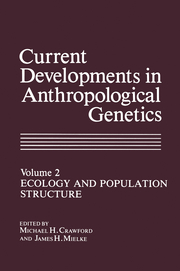Detailansicht
Current Developments in Anthropological Genetics
Ecology and Population Structure, Current developments in anthropological genetics 2
ISBN/EAN: 9781461567714
Umbreit-Nr.: 5902140
Sprache:
Englisch
Umfang: xvii, 525 S., 27 s/w Illustr., 525 p. 27 illus.
Format in cm:
Einband:
kartoniertes Buch
Erschienen am 04.06.2013
Auflage: 1/2013
€ 53,49
(inklusive MwSt.)
Nachfragen
- Zusatztext
- This volume examines the interrelationship of ecology, subsistence pat terns, and the observed genetic variation in human populations. Hence, the book is divided conceptually into the following categories: nonhuman primates, hunters and gatherers, nomads, swidden agriculturalists, peas ant farmers, religious isolates, and modern and urban aggregates. While many of these populations have experienced (and are experiencing) ac culturation as a result of contact with technologically more advanced groups, the genetic structures described in this volume attempt to recon struct the traditional patterns as well as genetic changes because of con tact. Most chapters also integrate biological (genetic), social, and de mographic data within an ecological frame thus presenting a holistic view of the population structures of ecologically distinct groups. The first chapter examines the body of early nonhuman primate lit erature that emphasized ecological determinism in effecting the popula tion structure of our primate ancestors-relatives. It also examines more recent literature (since 1970) in which it became apparent that greater flexibility exists in primate social structure within specific environmental frameworks. Thus, it appears that our nonhuman primate evolutionary heritage is not one of ecological determinism in social organization but one of flexibility and rapid change suggesting the evolutionary success of our species is based upon a system of flexibility and that social ad aptations can be accomplished in a number of diverse ways.
- Autorenportrait
- Inhaltsangabe1. Primate Social Organization, Ecology, and Genetic Variation.- 1. Introduction.- 2. The Comparative Method: Fantasy and Fact.- 3. Models of Ecology and Behavior.- 4. Implications for Genetic Research.- 5. Population Structure of Cayo Santiago.- 5.1. History and Demography.- 5.2. Social Group Organization.- 5.3. R-matrix Analysis.- 5.4. Results.- 5.5. Discussion.- 6. Conclusion.- References.- 2. Population Structures of Ghanzi and Ngamiland !Kung.- 1. Introduction.- 2. Previous Research.- 3. Study Populations.- 3.1. Ngamiland !Kung.- 3.2. Ghanzi !Kung.- 4. Methods.- 5. Fertility.- 6. Social Patterns.- 7. Mortality.- 8. Conclusions.- References.- 3. Population Structure of Circumpolar Groups of Siberia, Alaska, Canada, and Greenland.- 1. Introduction.- 2. Methods.- 2.1. Analytical Approaches.- 2.2. Populations.- 3. Results.- 3.1. The Broad Circumpolar Picture.- 3.2. Siberian Population Structure.- 3.3. Eskimo Population Structure.- 3.4. MATFIT.- 3.5. RST.- 3.6. Intrapopulational Analysis.- 4. Conclusions.- 4.1. Population History.- 4.2. Geographical Distance Factors.- 4.3. Cultural and Demographic Factors.- References.- 4. Ecology and Biological Structure of Pastoral Isseqqamaren Tuareg.- 1. Introduction.- 2. Pastoralists in an Hyperarid Area.- 3. Social and Geographic Structures.- 3.1. An Ecological Axis.- 3.2. A Parental Axis.- 3.3. The Feudal Hierarchy.- 4. Other Aspects of Isseqqamaren Dynamics.- 4.1. Social Status.- 4.2. Agriculture.- 4.3. Social and Economic Change.- 5. A Field Example of Biological Studies in Tuareg Isseqqamaren: Marriages in Ideles.- 5.1. Ideles: Habitat and Population.- 5.2. Demographic Aspects.- 5.3. Genetic Aspects.- 6. The Tuareg Isseqqamaren Gene Pool: Preliminary Results for Some Genetic Markers.- 6.1. Red Cell Antigens.- 6.2. Hemoglobin and Enzyme Polymorphisms.- 6.3. Haptoglobin and Group Component (Vitamin D Binding Protein) Subtypes.- 6.4. Immunoglobin Gm Antigen Polymorphisms.- 7. Conclusion.- References.- 5. The Population Structure of the Romany Gypsies.- 1. Introduction.- 2. Historical Background.- 3. Demography.- 3.1. Consanguinity.- 4. Genetic Structure.- 4.1. ABO Blood Groups.- 4.2. Rhesus (D and d Genes Only).- 4.3. MN.- 4.4. Haptoglobins.- 4.5. Red Cell Enzymes.- 4.6. Genetic Distance.- 5. Discussion and Conclusion.- References.- 6. Genetic Architecture of Swidden Agricultural Tribes from the Lowland Rain Forests of South America.- 1. Introduction.- 2. Swidden Agriculture and its Social Concomitants.- 2.1. The Ecological Setting.- 2.2. Swidden Agriculture.- 2.3. The Village as an Economic and Social Unit.- 2.4. Village Demography.- 2.5. Fission, Fusion, and Exogamy.- 3. The Survival of New Mutations.- 3.1. Rare Variants and Private Polymorphisms.- 3.2. The Age of a Mutant Allele.- 3.3. Estimation of the Mutation Rate.- 3.4. Complications and Caveats.- 4. Fission Effects in the Formation of New Villages.- 4.1. Fission as a Bottleneck in Effective Population Size.- 4.2. Village Fission in the Yanomama: A Case Study.- 5. The Genetic Consequences of Fusion and Exogamy.- 5.1. Genetic Disequilibrium Within Villages.- 5.2. Internal Correlation as a Function of Village Size.- 5.3. Homogenization as a Consequence of Genetic Exchange.- 6. The Production of Tribal Infrastructure and the Evolutionary Radiation of Tribes.- 6.1. The Balance Between Cohesive and Dispersive Forces.- 6.2. Dialect Clusters in the Yanomama.- 6.3. Miniclusters in the Yanomame and Makiritare.- 6.4. Fragmentation and the Network of Relationship.- 7. A Prospectus for Future Work.- 7.1. A Brief Recapitulation.- 7.2. The Need for a Formal Predictive Theory.- 7.3. The Neutrality of Rare Variants.- 7.4. The Ecological Demography of Populations.- 7.5. The Fission-Fusion-Exogamy Dynamic.- 7.6. A Final Note.- References.- 7. Genetic Structure of the Semai.- 1. Introduction.- 2. The Semai Senoi People.- 3. Semai Local Populations.- 4. Semai Marriage Patterns.- 5. Semai Demography.- 6. Fission-Fusion and Lineal/Kinship Effect.- 7.
